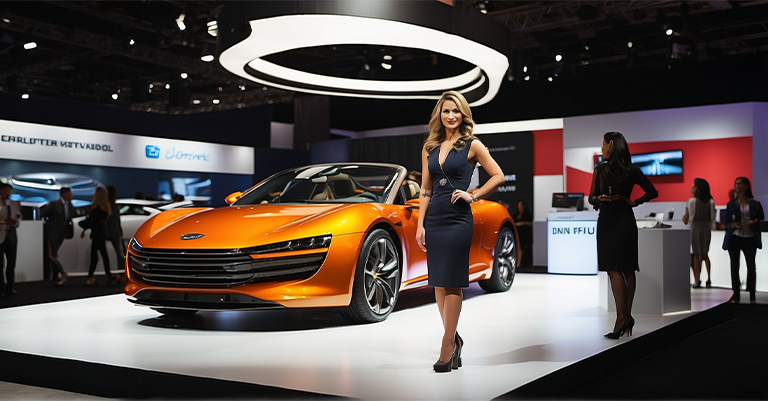How do brands truly stand out in the trade show world where digital content bombards attendees every second? Simple. Experiential marketing! This post will explore what it is and why experiential marketing works.
What is Experiential Marketing?
Imagine attending a trade show. Instead of just walking past booths with banners and flyers, you stumble upon a booth inviting you to immerse yourself in a virtual tour of a new hotel resort. Or perhaps, at another stall, you get to customize a piece of clothing using a unique piece of tech and then watch it being 3D printed right in front of you. That’s experiential marketing – it’s not about telling consumers about a product or service but about letting them experience it. By engaging multiple senses, this form of marketing creates a deeper bond between the consumer and the brand, making the interaction memorable.

The Evolution of Marketing Strategies in the Trade Show Industry
Trade shows, historically, have been avenues for businesses to display their offerings, network, and close deals. However, with the evolution of technology and a shift in consumer behavior, merely showcasing a product is no longer enough. People crave experiences, something tangible and memorable. This has led to the rise of experiential marketing in the trade show arena.
The transition has been evident. Earlier trade shows were mostly about information dissemination. Now, they’ve morphed into experiential hubs where brands compete based on their product and the experience they offer. This shift has made trade shows more engaging and amplified the ROI for businesses that do it right.
Experiential marketing in the trade show industry responds to a more demanding, tech-savvy, and experience-craving audience. It’s a way for brands to say, “Don’t just listen to us; experience what we have!” And trust me, in today’s saturated market, experiences speak louder than words.
The Power of Experience
Step into any room, and you’ll find that memories of past experiences often overshadow details of products or services. There’s an inherent reason for this. Experiences touch us, mold us, and leave a lasting imprint on our psyche. But why is that? And in an age where the digital realm is so pervasive, how does the tangible balance with the intangible?

The Human Psychology Behind Experiences
Human beings are emotional creatures. We might love to think of ourselves as logical and analytical, but at our core, emotions drive many of our decisions. Experiences tap directly into this emotional core. Whether it’s the adrenaline rush from a roller coaster ride, the serene calm from a walk on the beach, or the joy of an interactive event at a trade show, experiences stimulate emotions. And these emotions create memories much more potent than any advertisement or promotional content could.
From a psychological standpoint, experiences engage multiple senses – sight, sound, touch, and sometimes taste and smell. This multisensory engagement forms robust neural connections in our brains, making the experience more memorable and influential. In essence, when brands offer experiences, they’re not just promoting a product; they’re embedding a memory.
Real-Life vs. Digital: Finding the Ideal Balance
Now, let’s address the elephant in the room. In our digital age, where virtual reality, augmented reality, and other tech innovations have blurred the lines between the real and virtual, where does the balance lie?
The beauty of our modern era is that experiences are no longer limited to the tangible. Digital experiences can be just as impactful, if not more so, than real-life ones. The trick is in the execution. A well-crafted virtual reality tour can evoke the same awe and wonder as physically being in a location. An engaging online workshop can provide the same value as a face-to-face session.
However, the key is authenticity. The experience should feel genuine, engaging, and aligned with the brand’s essence, whether real-life or digital. There’s no one-size-fits-all answer here. Some brands might thrive with real-world experiences, while others might find their niche in the digital realm. The best strategies often involve a blend of both, leveraging the strengths of each to create a seamless and powerful experiential journey.
While the mediums differ, the core principle remains: Engage, evoke emotion, and leave a lasting impression. That’s the true power of experience.
The Benefits of Experiential Marketing
Why does experiential marketing stand out in the vast sea of marketing strategies? The answer lies not just in the dazzle of unique events or interactive sessions but in its deeper, more profound impact on consumers. Let’s explore some of these benefits.

Creating Memorable Moments
Think back to the most impactful advertisements you remember. Are they merely visuals on a page or screen? Or are they tied to an emotion, a feeling, or even a personal experience? Experiential marketing excels in crafting these unforgettable moments. It creates stories and memories by allowing consumers to interact, touch, feel, and immerse themselves in a brand’s offering. These memories aren’t just passive recollections; they become stories that consumers share, turning them into brand ambassadors. After all, a story lived is infinitely more compelling than a story told.
Building Brand Loyalty
Loyalty isn’t just about repeat purchases or recognizing a logo. It’s about creating a bond, a connection that consumers feel with a brand. Experiential marketing fosters this bond by providing value beyond the product or service. Whether it’s the exhilaration of an adventure event, the insights from a workshop, or the sheer joy of an interactive game, these experiences show consumers that a brand understands and values them. Over time, this understanding and appreciation translate into trust, which is the bedrock of loyalty. In a market crowded with options, loyalty is gold.
Fostering Authentic Connections
The word ‘authentic’ might be overused in today’s marketing parlance, but its essence remains crucial. Consumers are savvy; they can differentiate between genuine engagement and a sales pitch. Experiential marketing, done right, leans heavily on the former. By providing platforms where consumers can engage with brands in meaningful ways – be it through discussions, feedback sessions, or collaborative events – it breaks down the traditional barriers of business. Instead of a monologue, it’s a dialogue. Instead of a transaction, it’s a relationship.
The benefits of experiential marketing stretch far beyond the immediate dazzle of an event or interaction. They seep into the very relationship between a brand and its consumers, enriching it, and making it more robust. In a world where consumers crave connections and genuine engagement, experiential marketing isn’t just an option; it’s a necessity.
Trade Shows and Experiential Marketing
Trade shows have always been about showcasing products, ideas, and innovations. They’re hubs of activity where businesses compete for attention, hoping to make a lasting impression. In recent years, with the evolution of marketing dynamics and technological advancements, the landscape of trade shows has transformed. Enter experiential marketing, a powerful tool that’s redefining how brands connect at these events.

The Blend of Physical and Virtual
Traditionally, trade shows were purely physical events. Attendees would walk through aisles, pick up brochures, watch demos, and engage in face-to-face conversations. Fast forward to today, and the scenario has evolved. While the tactile, in-person aspect remains crucial, there’s an increasing blend of digital elements.
Virtual reality (VR) stations where attendees can take a tour of a facility from the comfort of the trade show booth, augmented reality (AR) apps that overlay additional information or visuals onto physical products, and interactive touchscreens that provide a deep dive into services – these are just the tip of the iceberg. The fusion of physical and digital allows brands to amplify their reach, engage users in unique ways, and provide richer, multi-dimensional experiences.
Strategies Used by Leading Brands
Top brands, always in pursuit of the next big thing, have been quick to adapt and innovate in the realm of experiential marketing at trade shows. Here are some strategies employed by the front-runners:
- Interactive Booths: Gone are the days of static displays. Leading brands now have booths that invite participation – be it through touch, sound, or even motion sensors.
- Gamification: Turning product displays or brand information into games not only makes it fun but also increases retention. Whether it’s a digital leaderboard at the booth or an AR treasure hunt, gamification is a hit.
- Live Demonstrations: Instead of just displaying a product, brands are now showcasing its creation. Think 3D printing a product model or assembling a gadget live on the show floor.
- Personalized Experiences: Using tech like facial recognition or data analytics, brands tailor the booth experience to each visitor, making it more relevant and engaging.
- Virtual Attendance: For those who can’t attend in person, brands offer virtual trade show experiences, ensuring they don’t miss out on potential leads.
- Feedback Loops: Leading brands don’t just speak; they listen. Incorporating real-time feedback mechanisms, be it through digital kiosks or instant polls, helps them tweak their offerings and engage better.
The trade show landscape is no longer about who has the flashiest booth. It’s about who provides the most memorable, engaging, and meaningful experience. And in this arena, experiential marketing is proving to be the MVP, with leading brands harnessing its power to stand out and create genuine connections.
Implementing Experiential Marketing
The magic of experiential marketing is evident. But how does a brand transition from traditional marketing approaches to this immersive, interactive strategy? Furthermore, once implemented, how does one gauge its effectiveness? Let’s dive into these crucial aspects.

Steps to Start with Experiential Marketing
Understand Your Audience: Before anything else, know who you’re targeting. What are their preferences, habits, pain points, and desires? Tailor your experiences to resonate with this demographic.
- Set Clear Objectives: Are you looking to increase brand awareness, launch a product, gather feedback, or foster loyalty? Your goals will shape the experiential strategy.
- Brainstorm Creatively: Think outside the box. Experiential marketing thrives on innovation. Assemble a diverse team and explore a myriad of ideas.
- Leverage Technology: Incorporate tech tools like VR, AR, mobile apps, and interactive screens to make the experience more immersive.
- Plan Logistically: While creativity is key, practicality shouldn’t be overlooked. Consider factors like venue, equipment, manpower, and budget.
- Engage & Interact: Experiential marketing is a two-way street. Don’t just showcase; engage. Encourage participation, feedback, and dialogue.
- Promote the Experience: Use traditional and digital channels to generate buzz about your event or campaign. Social media, especially, can amplify reach.
- Train Your Team: Ensure that everyone involved, from the planners to the on-ground staff, understands the vision, goals, and mechanics of the experiential campaign.
- Iterate and Adapt: Be ready to tweak elements on the go. Experiential marketing is dynamic, and flexibility can enhance the outcome.
Measuring the Success
- Quantitative Metrics: Track parameters like footfall, participation numbers, sales conversions, and lead generation to gauge immediate success.
- Qualitative Feedback: Surveys, focus groups, and one-on-one interactions can provide insights into how the experience impacted the audience’s perception and feelings.
- Social Media Engagement: Monitor mentions, shares, hashtags, and discussions related to your campaign on platforms like Twitter, Instagram, and Facebook.
- Retention and Loyalty: Over time, assess if there’s an increase in customer retention, repeat purchases, or membership sign-ups.
- ROI Calculation: Compare the costs of implementing the experiential campaign against the tangible and intangible returns.
- Competitor Benchmarking: Understand how your experiential efforts stack up against competitors. This can offer insights into areas of improvement.
In conclusion, while the allure of experiential marketing is undeniable, its implementation requires meticulous planning, creativity, and adaptability. And, like all marketing efforts, its true value emerges when the brand takes steps to measure, learn, and iterate based on outcomes. By embracing this vibrant marketing avenue and fine-tuning strategies based on insights, brands can craft unforgettable experiences and forge deeper connections.
Challenges and How to Overcome Them
Experiential marketing, while powerful and transformative, isn’t without its challenges. Like any endeavor, brands may face obstacles along the way. But forewarned is forearmed! Let’s explore potential pitfalls and how savvy marketers can sidestep or address them for maximum results.

Potential Pitfalls
- Misreading the Audience: One size does not fit all. An experience that resonates with one demographic might fall flat with another.
- Over-relying on Tech: While technology can amplify an experience, leaning too heavily on it can alienate those who seek human touch or find tech overwhelming.
- Logistical Oversights: An excellent experiential idea can crumble if logistical aspects like venue suitability, permissions, or safety measures are overlooked.
- Lack of Follow-up: If brands don’t engage with participants post-event, the momentum and goodwill generated can dissipate quickly.
- Inadequate Promotion: An experiential event without adequate buzz or audience awareness can end up being a missed opportunity.
- Ignoring Feedback: Not taking participant feedback seriously or not making adjustments can hamper the effectiveness of future campaigns.
Pro Tips to Maximize Results
- Deep Dive into Data: Use analytics and audience research to craft experiences tailored to your target demographic. Know their preferences, pain points, and aspirations.
- Balance Tech with Touch: Blend cutting-edge tech with genuine human interaction. Remember, the goal is to create a memorable connection, not just a flashy show.
- Attention to Detail: Ensure you have a checklist for all logistical requirements. Consider elements like crowd control, accessibility, and emergency protocols.
- Engage Post-Event: Use email newsletters, social media, or personalized messages to keep the conversation going after the experience ends.
- Build Hype: Utilize influencers, teasers, social media campaigns, and PR to generate excitement and anticipation well before the D-day.
- Iterative Approach: After each campaign, assess what worked and what didn’t. Act on feedback, and be willing to adapt and evolve.
- Collaborate: Consider partnering with complementary brands or influencers. This not only divides the logistical load but also amplifies reach.
- Prioritize Authenticity: Ensure your experiential marketing aligns with your brand values and ethos. Authenticity fosters trust and deeper engagement.
In a nutshell, while challenges in experiential marketing are par for the course, they are not insurmountable. With proactive planning, continuous learning, and a genuine desire to connect with the audience, brands can navigate pitfalls and elevate their experiential marketing game. It’s all about creating moments that resonate, engage, and linger in memories. And with the right approach, the sky’s the limit!
The Future of Experiential Marketing
Experiential marketing, a force that’s revolutionizing brand-customer interactions, is not static. As with all facets of business and technology, it evolves, morphs, and adapts to changing paradigms. So, what does the future hold for this dynamic marketing avenue? Let’s delve into some predictions and trends that could shape the experiential landscape in the coming years.

Predictions
- Hyper-personalization: With advancements in data analytics and AI, brands can craft experiences tailored to individual preferences, past interactions, and even moods. Expect experiences that resonate deeply on a personal level.
- Sustainable and Socially Responsible Events: Conscious consumers demand brands that align with their values. Future experiential events will prioritize sustainability, ethical considerations, and social responsibility, creating a deeper emotional connection.
- Blending the Physical and Digital Realms: The integration of AR, VR, and mixed reality will continue, crafting hybrid experiences that leverage the tactile nature of the physical and the vast possibilities of the digital.
- Growth of Virtual Events: While in-person experiences have their unique charm, the rise of virtual platforms and events, accelerated by global situations like the COVID-19 pandemic, will continue. Brands will craft immersive virtual experiences that rival in-person ones.
- Emphasis on Well-being: As health and mental well-being become central to consumers, expect experiences that rejuvenate, educate, or promote wellness.
Trends to Watch
- Localization of Experiences: Recognizing global audiences’ diverse tastes and preferences, brands will localize events, ensuring cultural relevance and resonance.
- Integration of IoT: The Internet of Things will play a bigger role, with smart devices, wearables, and connected environments enriching the experiential canvas.
- Dynamic Feedback Systems: Real-time feedback during experiences will become the norm, with brands adapting and tweaking events on the go based on participant reactions.
- Collaborative Experiences: More brands will join forces, creating collaborative experiences offering multi-faceted engagement and maximizing resources.
- Ephemeral and Pop-up Events: The charm of limited-time events, akin to pop-up stores or Snapchat stories, will grow. These fleeting experiences can generate buzz and FOMO, driving rapid engagement.
The future of experiential marketing is ripe with possibilities, fueled by technological advancements, changing consumer preferences, and a relentless pursuit of deeper, meaningful interactions. For brands, staying ahead of the curve, embracing innovation, and keeping a pulse on consumer desires will be crucial. Those who can anticipate, adapt, and innovate will craft memorable experiences and forge lasting bonds in this ever-evolving landscape. The future, indeed, looks experientially bright!

Closing Thoughts on Why Experiential Marketing Works
Experiential marketing has clearly cemented its place as a game-changer in the world of brand engagement. It transcends traditional advertising, offering a tangible, immersive interaction that speaks directly to the human desire for connection and memorable experiences. Whether through tech-infused wonders, deeply personalized engagements, or moments of sheer, unadulterated joy, it’s all about forging genuine bonds between brands and their audiences.
As we’ve explored, this realm is not without its challenges. Yet, the brands that navigate these waters with agility, authenticity, and a true understanding of their audience’s heartbeats will find a treasure trove of loyalty, advocacy, and deep-rooted connection.
Looking ahead, the horizons of experiential marketing promise even more excitement. The opportunities are boundless with the convergence of technology, art, culture, and human emotion. For marketers, the mandate is clear: Dive deep, innovate relentlessly, and always, always prioritize the human experience.
In a world increasingly dominated by digital blips and short attention spans, experiential marketing stands out as a beacon, reminding us of the power of the ‘now,’ the joy of the ‘moment,’ and the lasting impact of a ‘memory.’ It’s not just marketing; it’s a journey of senses, emotions, and relationships.




